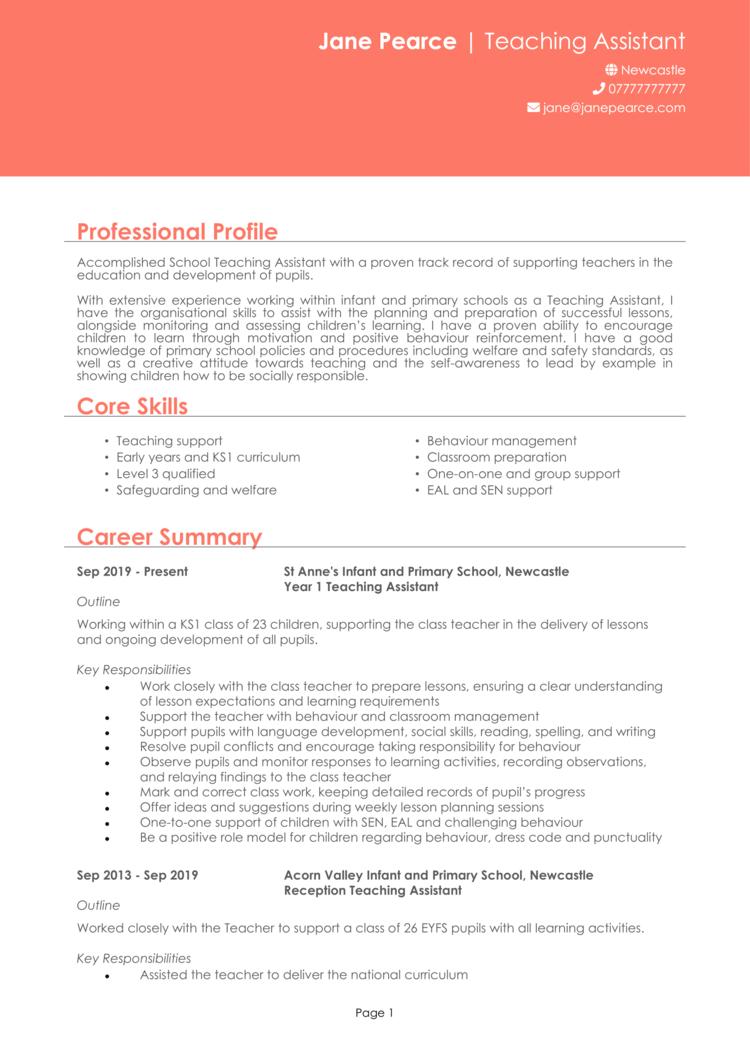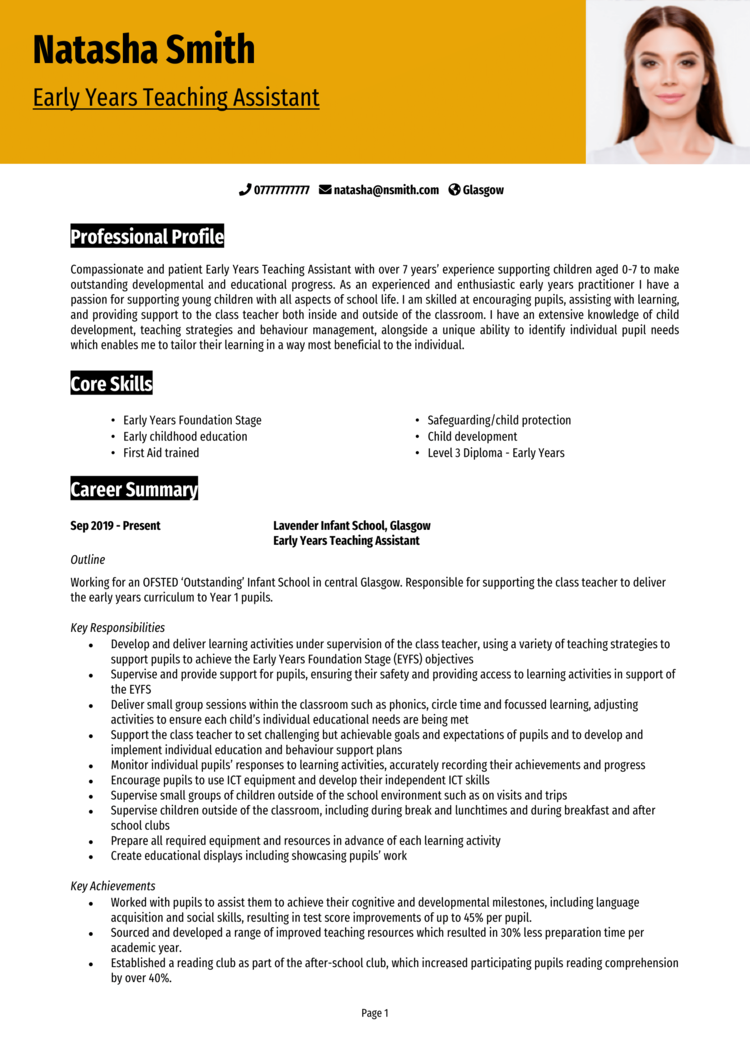
Teaching assistant CV examples & guide
If you’re looking to land a top teaching assistant (TA) role, it’s vital that you have a quality CV.
A strong teaching assistant CV needs to be well formatted, and contain the right content to impress recruiters and teaching employers.
This guide tells you everything you need to know about writing a first-class CV for teaching assistant roles, and even contains a teaching assistant CV example, to show you exactly how your CV should look.
CV templates
Teaching assistant CV example

CV templates


SEN teaching assistant CV example

CV templates

CV templates
Early years teaching assistant CV example

CV templates


Teaching assistant CV example (no experience)

CV templates


See also: Our teacher CV example
How to write your teaching assistant CV
Now that you’ve seen how your CV (curriculum vitae) should look - the following guide will tell you how to write your CV step-by-step and what content should be going into it.
Guide contents
- Format & structure your CV
- CV profile
- Work experience
- Teaching assistant skills
- Education & qualifications
- Hobbies & interests
CV structure and Format
Before you type one word on your CV, it’s important to understand how it should be laid out and formatted.
This diagram gives you a very high-level view of how your CV should be structured.
Try to stick to this layout as closely as you can.

Key CV structure points
Personal/contact details
Make sure recruiters can contact you easily by placing your contact details at the top of your CV.
Profile/Personal statement
Grab recruiter’s attention with a catchy paragraph selling your most valuable skills.
Core skills
A bullet pointed list of your skills split over two columns will give readers a great snapshot of your value.
Work experience
Show employers the impact you make in the workplace by detailing your previous roles thoroughly.
Education
Round your CV off with a detailed list of your education to prove you are qualified.
Remember to keep your CV at around 2 pages in length - anything longer and you risk losing readers’ attention.
Keep your CV style very simple with a clean font and muted colours - don’t be tempted to jazz it up with wacky colours or pictures, this can look unprofessional and messy.
Now let’s take a look at those sections in detail, and see what content needs to go into each one.

Contact details
At the very top of your CV, add your name and contact details, using up minimal space on the CV.
You want to make it extremely easy for recruiters to contact you - after all, that is the purpose of your CV!

Be sure to include…
Your phone number (mobile ideally so you can answer calls about jobs 24/7)
Your email address (Use a professional looking email address and not a nickname)
Your location (Just a rough area such as London/Leeds/Oxford)
Do not include…
Your full address - it’s not needed at this stage and will take up too much space
Your date of birth - Your age shouldn’t have any effect on a hiring decision
A photograph - Employers are only interested in what skills and knowledge you can bring to their school, they aren’t concerned with how you look.
CV profile / personal statement
To hold the attention of recruiters and school staff reading your CV, it’s essential to sell yourself with a quick punchy paragraph at the top.
Your profile or personal-statement should give a nice summary of your skills, experience, qualifications and knowledge.

(You can see more CV profile examples here)
The idea is to sell yourself, and encourage readers to continue reading your CV.
So, what kind of info should you put into your teaching assistant CV profile?
At this stage in your CV, schools will want to know these types of details…
- Types of schools you have worked in
- Ages of children you work with
- Teaching related qualifications
- Subjects or curriculums you have knowledge of
- Skills related to teaching - Classroom management, supporting teachers etc
- Anything else that could be relevant to the jobs you are applying for.
Avoid writing too many cliché phrases like, “works well in a team or individually” because they don’t tell readers anything factual about you.
Quick tip: If you worry that your spelling and grammar might not be correct, try using our quick-and-easy CV Builder to eliminate the risk of making mistakes.
CV templates
Core skills section
If you really want to make sure that you grab recruiters’ attention in those vital first few seconds of them opening your CV - you need to add a core skills section.
Like this one.
All you need to do is list your most vital skills and knowledge in a bullet pointed list.
By adding this section, anybody who opens your CV can get a very good idea of your abilities from just a quick glance - perfect for creating a big impact.
CV templates
Your work experience
To show recruiters and potential employers that you can contribute plenty of value in the workplace, you need to give a detailed account of your work experience.
If you have experience working within schools or other educational settings, that’s great - and you should focus on it within your CV.
If you don’t have any direct education experience - that’s OK. You just need to focus on drawing out transferable skills from your previous work (I’ll talk about what those skills are later in this post) or even consider getting some voluntary experience first.
To start with, order your roles in reverse chronology, which means start with the most recent job, and work down to your older roles - like the diagram below.
Structuring your role descriptions
To ensure that your roles are easy to read and show recruiters how you contribute to employers’ success, it’s important to structure your roles properly.
Use this simple but effective method to structure your roles.
- Outline
- Responsibilities
- Achievements
This annotated example shows you how it works in practice
Start by detailing the start and finish dates of your roles (month and year) along with the name of your employer and job title
e.g.
Jan 2013 - Nov 2016 Long Lane Primary School | Primary Teaching Assistant
Then head the role with an outline which tells readers, who you work for (school, year group etc.) and what the overall goal of the role is.
Then list your responsibilities for the job in a series of short sharp bullet points to explain your input, show who you interact with, and showcase your skills.
Typical responsibilities could look like this:
- “Designing and creating classroom displays to aid students in learning ongoing topics”
- “Supporting class teacher in classroom management and keeping students focused”
Once you’ve listed your responsibilities, throw in some impressive achievements to really wow recruiters.
Achievements should give examples of times where you have gone the extra mile to help your employer, students or colleagues
For example…
- Ran after school revision workshops and all attendees achieved 80% + exam scores
- Introduced new reward system which greatly improved classroom behaviour
See our best CV templates for more examples of role structures.

Teaching assistant skills
When writing your CV roles (and the rest of your CV) it’s important to know exactly what recruiters are looking for, so you can reflect relevant skills.
So here is a quick list of some important skills and knowledge that recruiters will be expecting from a teaching assistant.
Some of these will require direct experience previously working in a teaching related role, whereas some of these skills can be gained in other workplaces or even study - so be creative if you don’t have the exact experience.
- Working with children - Teaching assistant work involves constant interaction with children of varied ages, so it helps to have some previous experience working with young people. This could be gained in a school, or perhaps in youth centres, sports clubs etc.
- Communication - Communication skill are vital in the classroom, so it pays to pack your CV with examples of your written, spoken and visual communication talents.
- Supporting teachers - The TA role revolves around supporting the class teacher so be sure to include this on your CV, or at least occasions where you have supported other senior staff.
- Behaviour management - Ensuring students are well-behaved and focused on work.
- Reading, writing and numeracy - An educational role will require you to have high standards across all three of these areas.
- Planning - Helping students to make progress requires long-term planning, which TA’s will likely support their class teacher with.
- Administration tasks - Admin is a vital part of many roles, and within a TA’s role it could involve photocopying class work, or filing attendance records.
- Creating displays - Teaching assistants need a healthy dose of creativity and artistic flair to create engaging classroom displays.
- Teaching qualifications - Whilst teaching qualifications aren’t necessarily needed for TA roles, it can be helpful to have them. GCSE’s in maths in English are an entry requirement though.
Education
Round your CV up by listing your education at the bottom, including GCSE’s, A-levels, vocational qualifications etc.
Format the roles by listing:
- School/college attended
- Attendance dates
- Qualifications
- Grades
Any qualifications that are highly relevant to teaching assistant roles (such as Maths GCSEs or teaching qualifications) should also be mentioned at the top of your CV in the profile to ensure they aren’t missed.
Hobbies and interests
Hobbies are an optional section, but you can add them if you think they will add value to your applications.
For example, if you don’t have much school experience, but you volunteer at local kid’s clubs in your spare time, then it would certainly be worth mentioning that in your CV.
Conclusion - create an impressive teaching assistant CV
If you’re looking to land a top teaching assistant job, use the above outlines to ensure you attract recruiters and impress employers.
Start by doing some research and looking at teaching assistant roles online to find out more about what your target employers are looking for.
Create an easy-to-read structure for readers, kick your CV off with an eye-catching profile, and cram your roles full of highly relevant skills and knowledge.
Once you’ve perfected your CV, proofread it and remove any typos before sending it out to plenty of recruiters and employers.
Good luck with your job search
CV templates
Link nội dung: https://studyenglish.edu.vn/cv-for-teaching-assistant-a42185.html